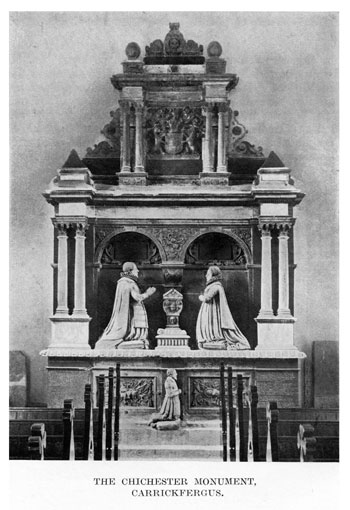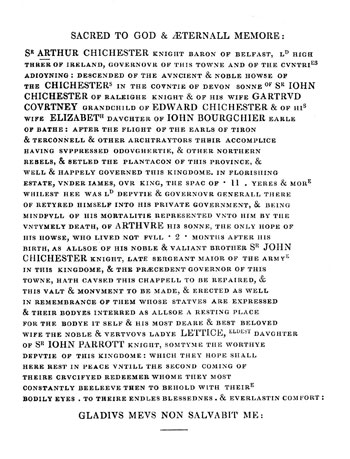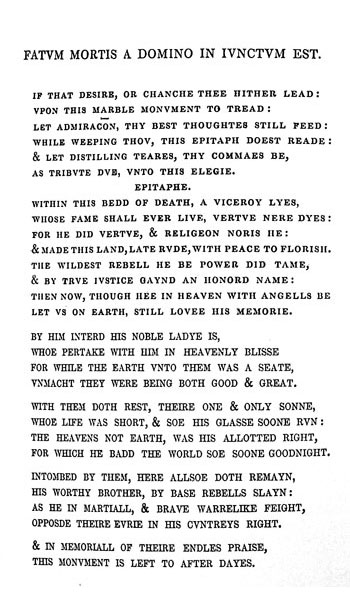THE BUILDING OF BELFAST CASTLE.
When Sir Arthur Chichester, the younger son of Sir John Chichester of Rawlry, near Barnstable, Devonshire, was granted by Patent of James I, 8th November, 1603, "the Castle of Bealfaste, or Belfast, with the Appurtenants and Hereditaments, Spiritual and Temporal, situate in the Lower Clandeboye", he did not fully realise the value of the property thus granted. In a letter to R Cecil, 1st Earl of Salisbury, he says :--
"When I have it at best perfection I will gladly sell the whole landes for the wch others sell, five pounds in fee simple in these partes of the Kyngdome."
1st February, 1603-4.
He was appointed Lord Deputy of Ireland in the following year, at a salary of £1,000 per annum, together with £500 for an outfit and some fees attaching to his office. But on the death of the preceding Lord Deputy, Charles Blount, 5th Baron Mountjoy and Earl of Devonshire, Sir Arthur wrote to Cecil, 25th April, 1606, asking to be transferred to "some meaner office" giving as his reason that his "fortunes are poor, not having a foot of land or inheritance, but such as his Majesty gave him in the North, of which he makes small benefit, and his expenses last year greatly exceeded his income." Even three years after he had become the proprietor of the lands upon which that part of the City of Belfast, situated in the County of Antrim, now stands, he apparently failed to realise the potential value of his acquisitions. In the development of that property, however, he was retarded by the onerous and exacting duties attaching to his high office, and it was not until after 1610 that the project of building a new Castle upon "the Ruynes of the decayed Castle" was carried to completion. The manuscript Report of the Plantation Commissioners is in Lambeth Palace Library (cod. 630, fol. 144).
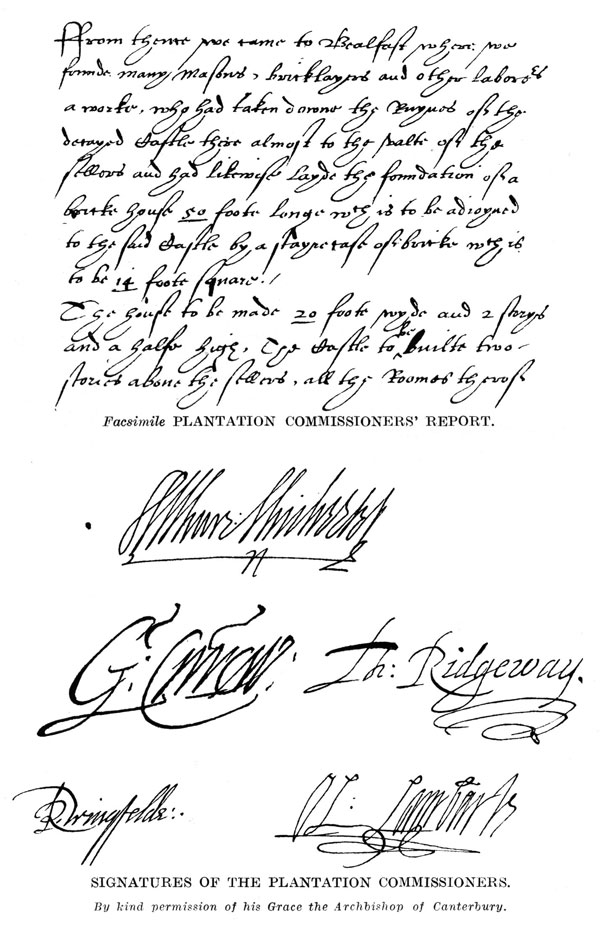
The Report, undated, but supposed to be about 1611, bears the following signatures :-- Arthur Chichester (Sir Arthur Chichester, Lord Deputy of Ireland: created Baron of Belfast, Patent, 23rd February, 1612); G. Carew (George Carew, created Baron Carew of Clopton, in the County of Warwick, 4th May, 1605); Th: Ridgeway (Thomas Ridgeway, created Earl of Londonderry, 1619) ; R. Wingfelde (Sir Richard Wingfelde or Wingfield, created Viscount Powerscourt by Privy Seal, 1st February, 1619; Patent, 19th February, 1619); Ol: Lambarte (Sir Oliver Lambart, created Baron Lambart of Cavan, 1617).
The portion of the Report, appearing in Benn's History, pages 86-87, as taken from the Pinkerton MSS., is so erroneous that I reproduce a copy of the original, as checked by the Assistant Librarian Lambeth Palace Library, Miss I. J. Churchill, D.PhiL, in my presence.
"We came to Bealfast where we founde many Masons, bricklayers, and other laborers aworke who had taken downe the Ruynes of the decayed Castle there almost to the valte of the sellers, and had likewise layde the foundation of a bricke house 50 foote longe which is to be adionyed to the said Castle by no stayrecase of bricke well is to be 14 foote square.
"The house to be made 20 foote wyde, and 2 storys and a halfe high. The Castle is to be builte two stories above the sellers, all the Roomes therof to be valted, and platformes to be made therupon. The stayrcase is to be made 10 foote higher than the Castle, about which Castle and house there is a stronge bawne almost finished which is flankerd with foure halfe Bulworkes. The foundacion of the wall and bulworkes to the height of the watertable is made with stoane, and the rest, being in all 12 foote high above the grounde, is made with bricke, the Bawne is to be compased about wth a lardge and deepe ditch or moate wch will always stand full of water.
"The Castle will defend the passage over the foorde at Bealefast betweene the upper and lower Clandeboye, and likewise the bridge over the Ryver of Owynvarra between Malon and Bealfast. This worke is in so good forwardnes that it is like to be finished by the mydle of the next Somer.
"The Towne of Bealfast is plotted out in a good forme, wherin are many famelyes of English, Scotish, and some Manksmen already inhabitinge, of which some are artificers who have buylte good tymber houses wth Chimneyes after the fashion of the English palle, and one Inn wth very good Lodginges wch is a great Comforte to the travellers in those partes.
"Neere wch Towne the sd Sr Althur Chichester hath ready made above twelve hundred thowsand of good brickes, wherof after finishinge of the said Castle, house, and Bawne, there wilbe a good proportion left for the buyldinge of other tenemtes within the said Towne.
"Not farr from Bealfast the said Sr Arthure Chichester hath impalled a parke of three myle Compasse where he intendes to buyld a house of Lyme and stone, but a tymber house wth chimneys is already buylte therin, which is Compassed about with a Rampier of earth and soddes and a deepe ditch standinge full of water in wch house there nowe dwelleth one Liutent [Lieutenant] Lowsley with his famelie.
"A little from thence is a large house wth Chimneys buylte by Humfrey Norton Liuetent [Lieutenant] of the Lo: Deputies foote Companie wch house is well intrenched, rampierd, and fenced with a stronge palisado of tymber, wch house with a good proportion of Lande the said Norton houldeth by lease from his Lop [Lordship].
"In the waye to Knockfargus wthin 4 myles of that Towne we sawe a pritie stone house wth Chimneyes, two stories high, buylte by Michell Newbye, Ensigne to the Lo: Deputie. It is for the present covered wth tacch [thatch] but shalbe slated the next Somer. This is also upon the lande of the Lo: Deputies wch house with 300 acres of lande is lett to the said Newby at a smale rent for many yeares in respect of his service, and buyldinge theron.
"A myle from the former house but further from the Sea, as we passed towards Knockfargus, there is upon a hill syde a large house with Chimneyes wch is enclosed with a rampier of earth and soddes, and fiankerd, wch was buylte by Thomas Walsh late Cornitt of the said Lo: Deputies Troope, upon his Lops Lande, and is nowe inhabited by Liuetent Barrye who marryed the saide Walsh his wyddow, neere which there are many other tenemtes inhabited, some of them by such Cyvell Irish as doe speake English, and diuers of them have byne servitors in the late Queen's tyme.
"A myle and somewhat more from Knockfargus we sawe a farme house of the Lo: Deputies buylte of Tymber after the English fashion inclosed rounde with a bawne, ditched aboute, and a stronge hedge thereupon. the walles of wch house are latlie made up with stone. There are many Inclosiers neere the said house neewly made, with good ditches, sett with wyllowes and a great parte with quicksetts, where his Lop hath nowe a stocke of English Cowes, Sheepe, and other Cattell.
"Upon diuers other parcells of his Lops Landes there are many English famelies, some Scottes, and diuers Cyvill Irish planted, and there are three mylls already bnylte upon severall partes of the said Land; and Tymber and other Materialls are also provided for the buyldinge of onother mylle neere unto Bealfast."
"The Castle will defend the passage over the foorde at Bealefast betweene the upper and lower Clandeboye, and likewise the bridge over the Ryver of Owynvarra between Malon and Bealfast." In Wright's English Dialect, a Bawn is described as "a fortified enclosure or yard round a castle or country house -- originally as a defence for cattle against marauders ", and Murray defines it as "a fortified enclosure, enceinte, or circumvallation: the fortified court or outwork of a castle."
Dr. Thomas Molyneux visited Belfast in August, 1708, a few months after the Castle had been destroyed by fire, and, referring to "the courts and gardens" surrounding the ruins, he says: "These improvements are all included in a kind of Fortification, being Designed for a place of Strength as well as Pleasure." At a later date, 1736, the Marquis of Ormond says :-- "Defects in walls of the outward Bawne rendered it assailable" (Carte's Life). Whatever the opinion of later critics may be, there was a consensus of opinion among those who were competent to form a judgment at the time the Bawne existed that the Belfast Castle was a fortified place.
The four Half Bulwarkes were in the southerly direction and "the bridge over the Ryver of Owynvarra between Malon and Bealfast" was on the site of the present-day Boyne Bridge. It was in this neighbourhood, afterwards known as "Brick Kiln Land", that the "twelve hundred thousand of good brickes" were manufactured for the building of the Castle. A lease of 1698 contains the following parcels :--
"all that plott or parcel of ground lying and being in the Fields of Belfast on the S.W. part of the said town, between the Pound, where was formerly the great Sluice of the Mill Dam and the great bridge leading to Malone on the W. side of the highway, all along on the E. and S., and the River which now falleth from the Pound on the W.; together with all houses and buildings thereon... as also that plott of land containing one acre Irish measure, lying and being on the Fields of Belfast, on the S. side of the footpath leading to the said Bridge, and on the N. side of the said River; bounded on the E. with a Meadow in the tenure of the said Earl of Donegall; on the W. by the Highway leading to Malone, with all the Brick Hills and Brick Pitts as they are now held in the possession of the said R Dowglass."
In a later lease, bearing date 20th September, 1704, Eleanor Shaw was granted a 61 years' lease from March, 1704, of"the Land called the Brick Kiln Land in the Parish of Belfast containing 60 acres", On the following 29th December, the said Eleanor Shaw, widow of John Shaw, conveyed one third part of the 60 acres to her son (by a former husband) David Chalmers and to each of her two sons-in-Iaw, John Hamilton and Arthur McCartney and in the parcels of a Mortgage Deed there is a more definite location:-- "situate beyond the Brick Kiln Bridge on the right hand of the way leading up Malone." The 60 acres subsequently became vested in John Hamilton; and on 1st August, 1723, John Hamilton of Mazee, Co. Down, gentleman, conveyed his interest therein to William and Elinor Rainey, the executors of John Rainey.
On 21st August, 1728, in consideration of £100, the following premises, inter alia, were mortgaged :--
"That plot or parcel of land now in the possession of John Cobham, containing one acre Irish measure, situate in the Fields of Belfast, and on the N. side of the said River; bounded on the E. with the meadow in the tenure of the Earl of Donegall, and on the W. by the Highway leading to Mallon, with all the Brick Hills and Brickpitts and other appurtenances thereto belonging."
In an assignment, bearing date 20th April, 1754, there are the words :-- "ten acres, Irish measure, situate on the E. side of the Highway near the Brickkilns leading towards the Brick-kiln Bridge of Belfast"; and in a later deed there are the words :-- " Brickle Bridge."
As will be seen from the foregoing recitals, the district around the present-day Boyne Bridge was called by the different names of Brick Hills, Brick Pitts, Brick Kiln Land; and that the bridge spanning the Owynvarra had the different spellings of Brickill, Brick-hill, Brick-Kiln, and Brickle. It was in this district, "neare wch towne", that the 1,200,000 bricks were manufactured for building the Castle, the surplus of which could be utilised for the building of "good brick houses" in the town.
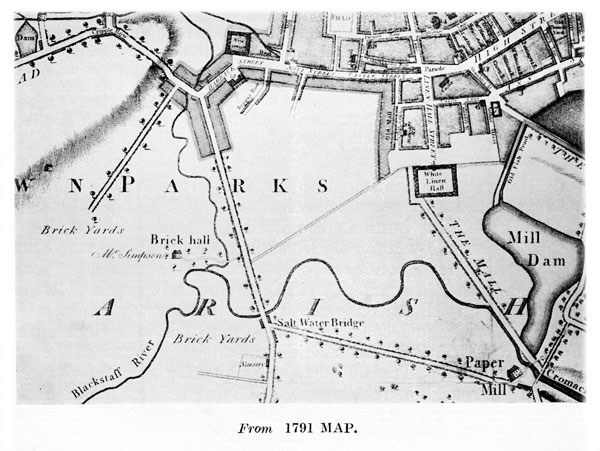
Various devices were adopted by which the use of brick would be encouraged, apparently for the purpose of substituting brick houses for "tymber houses." Burgage shares were granted in several instances because the lessee had "built a good Brick house". Frequent references to such houses are made in legal documents of the 17th and 18th centuries. Thus in 1692 we have "the great Brick House commonly called Sir Arthur Bassett's House." In 1728 "one great Brick House in High Street... late in possession of Lewis Thompson and William Leathes deceased... with the household furniture of the said Brick House"; and again in 1738: "all that Tenement or half Burgage share whereon Thomas Stuart built a large brick house on the N. side of Castle Street."
In 1757 the agent, Mr. John Gordon, wrote to the trustees of the Donegall Estate: "The brick grounds about the town are most part run out and Brick will be much wanted... The Buildings go on slowly at present for want of Brick", to which Mr. Ludlow, on behalf of the trustees, replied: "Everything should be done to encourage building". Benn, in referring to this correspondence, says, "They knew little about the resources of Belfast in the matter of brick-clay."
The Report indicates the position of the "parke of three myle compasse" only by the words "not fare from Bealfast." Unfortunately there are no available means of ascertaining the location of "the tymber house with chimneys... in which house there nowe dwelleth one Liutent Lowsley with his famelie." But taking into consideration that the Commissioners were moving from Belfast towards Carrickfergus, and, at the same time, describe the Parke as "not fare from Bealfast", we may infer that it was the district that has retained the name of Oldpark, situated on a portion of the Black Mountain, commonly called The Squire's Hill.
The origin of this name opens up a very interesting question. Benn says: "The beautiful hill sloping so near the town, called still 'The Squire's Hilr, may be supposed to have derived its name from Henry Le Squire" (p. 239). But his signature appears in the Corporate Records as Le Squyre. He was a lawyer and was appointed Agent and Seneschal by Lord Edward Chichester, on whose recommendation he was elected Sovereign of Belfast, commencing on the Feast of St. Michaels, 29th September, for the three years 1635, 1636, and 1639. He remained a Burgess till his death, when his successor, George Martin, was elected on 3rd October, 1645.
In his Last Will, dated 1643, given in full by Benn, p.239, after various bequests, including "£5 to the poor of Belfast" and "the Mace I have bee delivered to the Sufferane for the Town's use" he proceeds :--
"I give to my loving Brother Mr. George Le Squyre and to such child of his, as hee shall nominate, all the remainder of my term and estate in the lands and mill I hold at and about the Six Mile Water in County Antrim.
"I leave unto my loving wife, Grace Le Squyre, my freehold land in the parish of St. David's in Exeter in England, and I appoint her my sole Executrix."
There is no mention in the Will of any property in the vicinity of Belfast, the Six Mile Water being a river flowing into Lough Neagh at the town of Antrim and having its source in a north easterly direction.
But apart from there being no existing record of Henry Le Squyre possessing property "not fare from Bealfast", the use of the definite article is strong evidence that "The Squire" referred to the landed proprietor, Sir Arthur Chichester, who appropriated as a "Parke" that portion of the Black Mountain, in the neighbourhood of Ballysillan, which still retains the name of The Squire's Hill. "The Squire" denotes a member of the landed gentry, owner of a country estate.
In the middle of the 18th century, the brothers, David and William Lyons, were each granted a 41 years' lease of 88a. 3r. 20 per. in the "Old Deer Park", The acreage therein mentioned was a moiety of 177a. 3r. "part of the Old Deer Park" which had been leased to James Buller and Nicholas Thetford.
In a mortgage deed, bearing date 1st May, 1730, we get the following particulars:--
"The moyety of a parcell of land, being part of the Old Deer Park... commonly called and known by the name of Old Park, formerly in possession of Gilbert Wye gentleman which said moyety contains by estimation 88a 3r. 20 per."
Gilbert Wye was a Burgess from 1662 to 1684, as may be seen from the following entries in the Corporate Records:--
"17 September, 1662. That out of respect and affection wee have and beare to Gilbert Wye Esq., Steward to the Rt. Honorble ye Earle of Donegall, a person quallified in all respects as afforesaid, wee have ellected and chossen him the said Gilbert Wye to be one of the Burgesses of this Corporacion..."
"Memorandum of 24th June, 1684. Sr William Franklin produced to ye Soveraigne and Burgesses assembled at ye house of Mr. John Hamilton, then Soveraigne, a writing undr ye hand and seale of Mr. Gilbert Wye, one of the Burgesses of this Corporacon, in whose place Mr. Thomas Knox was ellected and sworne as afforesaid, notwithstanding some of the Burgesses where [sic] disatisfied that Mr. Wye should have been putt out of his place without a fault or a resignation, appearing contrary to Charter, but now all are satisfied by ye said resignation."
Apparently the 1st Earl of Donegall granted a lease of the "Parke", mentioned by the Commissioners in their Report, to his Steward, Gilbert Wye, at the time the New Deer Park was in process of formation. We, however, get a further insight to the "Parke" from the following two leases.
On 29th April, 1755, David Lyons, merchant, was granted a Donegall lease for 41 years from November, 1754, of
"all that parcel of land adjoining next to John Carson on the E. or N.E., and bounded on the W. to the Highway or Road leading from the Lodge to Ballysillan Mountain . . . which said parcel of land is part of the Old Deer Park, commonly called and known by the name of the Old Park and contains by estimation 88a 3r 20 per."
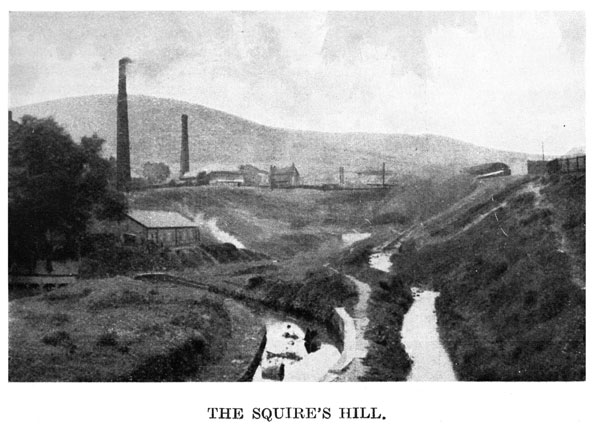
In the following year William Lyons, Linendraper, was granted a Donegall lease, bearing date 15th May, 1756, for 41 years from November, 1755, of :--
"all that part of land... 88a 3r 20 per., adjoining to the Long Causey, bounded on the E. or N.E. with the road leading from the Lodge to Ballysillan Mountain... which said premises are a moiety or half part of 177a 3r., part of the Old Deerpark, due to a division heretofore made thereof between James Buller and Nicholas Thetford."
The district now known as and called Oldpark must not be confused with the New Park, formed by the Lord Deputy's nephew, Arthur, 1st Earl of Donegall, which is recorded as having been in process of formation in 1666. It extended in an easterly direction from the Cave Hill towards Belfast Lough, terminating at Parkmount.
Considerable information is obtained from a conveyance, bearing date 21st November, 1795, to R Thompson of Jennymount, for the residue of 52 years from November, 1769, the parcels of which are :--
"all that farm containing the Lands of Skigoniel and quarter of Listilliard situate, lying, and being in Finamon Cave and Carmony, within the Parish and Barony of Belfast in the County of Antrim, formerly in the tenure and occupation of the said Thomas Ludford and his undertenants, and containing by admeasurement 313 acres and 17 perches, Plantation measure.
"And also all those several lands, closes, or parks called the Lower Wood, otherwise Parkmount, lying and being in Cinnamon Cave and Carmony, and containing by admeasurement 144 acres and 32 perches Plantation measure... and all houses, edifices, buildings and the improvements whatsoever then, or at any time thereafter, standing and being thereon, with a certain annuity or yearly sum of £120 sterling charged and made payable thereout to the said Edith Maria Lewis otherwise Bellamy by the Will of the said Thomas Ludford and which should from time to time grow due and be payable by virtue of said recited Will"
Thomas Ludford, by his Last Will, dated 12th January, 1776, describes himself as "Armiger, of Hayes in County of Middlesex", and refers therein to the property subsequently conveyed to R Thompson in 1795, as :--
"a leasehold of houses and lands under the Earl of Donegall in Ireland for the remainder of a term of 61 years which commenced in the year of our Lord 1761, with all their appurtenances of what kind soever, all which my own Family disowned me I give and bequeath to Mrs. Bellamy In Trust for herself and children, but in case they have anything to say to that infernal Hussey then to forfeit all and give them to the poor of Hayes for her impudent behaviour."
There are certain clauses in the Will of a personal nature :--
"... To be interred in the Cloysters of Westminster Abbey as near the remains of my dearly beloved Wife as possible in a private manner.
"I desire I may have a small pannelled monument erected in the Cloysters like what is already up belonging to my wife's family and as near them as may be possible.
From this supplementary information we learn that Thomas Ludford was granted by Arthur, 4th Earl of Donegall, a 61 years' lease from 1761 of 313 acres 17 perches in Cinamon Cave and Carmony, and also 144 acres 32 perches "called Lower Wood otherwise Parkmount"; that Thomas Ludford bequeathed that property to "Mrs. Bellamy In Trust for herself and children"; and that the legatees conveyed the property to R Thompson of Jennymount on 21st January, 1795, for the residue of 52 years from November, 1769.
The Will was in the hand-writing of Testator and, apparently, for the purpose of avoiding any dispute after his death, he made a copy, with the following endorsement :--
"This is a true copy of my Last Will and Testament, dated the 12th day of January, 1776, which I have deposited in the care of Mrs. Bellamy, Trustee to the Original. As witness my hand. Thos. Ludford."
-- -- -- -- -- -- -- -- -- -- --
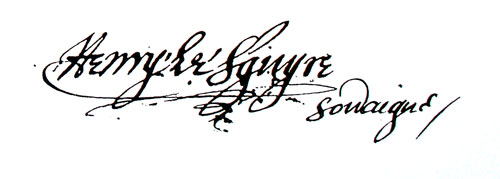
-- -- -- -- -- -- -- -- -- -- --
